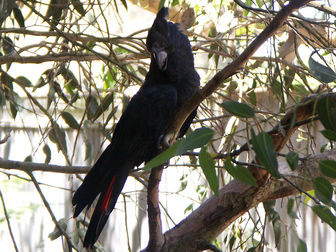Glossy Black-Cockatoo
The Glossy Black-Cockatoo , also known as the Casuarina Cockatoo after one of their preferred food items, is the smallest member of the subfamily Calyptorhynchinae found in Australia. Adult Glossy Black-Cockatoos may reach 50 cm in length and sexually dimorphic. Males are completely black in colour, excepting their prominent red tail bands; the females are dark brownish with some yellow spotting. Three subspecies are recognised.

Original source: Own picture/Photo personelle
Author: Didier B (Sam67fr)
Permission: GNU Free Documentation License
The Glossy Black-Cockatoo is classified as Least Concern. Does not qualify for a more at risk category. Widespread and abundant taxa are included in this category.
Glossy Black-Cockatoo range (in red) The Glossy Black-Cockatoo (Calyptorhynchus lathami), also known as the Casuarina Cockatoo after one of their preferred food items, is the smallest member of the subfamily Calyptorhynchinae found in Australia. Adult Glossy Black-Cockatoos may reach 50 cm (20 in) in length and sexually dimorphic. Males are completely black in colour, excepting their prominent red tail bands; the females are dark brownish with some yellow spotting. Three subspecies are recognised. More
The glossy black-cockatoo is around 46-50 cm long and is generally smaller than other black-cockatoos. It is a brownish black colour with a small crest. There are some distinct differences in appearance between male and female birds. The male can be identified by the browner colour on the head and underparts and by bright red panels in the black tail. The female has a wider tail which is red to reddish-yellow, barred with black. More
The glossy black-cockatoo is listed as vulnerable in NSW, under the Threatened Species Conservation Act. Another threat is the trade in pets. More
Glossy Black-Cockatoos are found in various places around Narrabri, New South Wales, especially in areas with Casuarina trees, such as Jack's Creek State Forest, other parts of the Pilliga scrub and also around the ATNF's radio observatory, 25 km west of town. Although sighted regularly by us in these areas in the years 2003-2006, in general they are quite rare. They live in small groups. Typical sightings are of two or three individuals, sometimes small groups of up to six birds. More
The Glossy Black-Cockatoo, (Calyptorhynchus lathami) is recognised as a threatened species under State legislation, and is the rarest of Australia’s cockatoos. South East Queensland (SEQ) has some of the most significant populations in Australia. Unfortunately, increased urban growth in the region is having adverse effects on this beautiful bird. They are known to feed and breed on private land in certain residential areas of Pine Rivers where she-oaks present. More
Glossy Black-Cockatoos live in pairs or famliy groups in eucalypt forest with casaurinas, their favored food source. There is a little doubt that this species has suffered from a loss of suitable habitat within its range. Distribution map of the Glossy Black-Cockatoo. More
The Glossy Black-cockatoo is a dusky brown to black cockatoo with a massive, bulbous bill and a broad, red band through the tail. The red in the tail is barred black and edged with yellow. The female usually has irregular pale-yellow markings on the head and neck and yellow flecks on the underparts and underwing. They are usually seen in pairs or small groups feeding quietly in she-oaks. They are smaller than other black-cockatoos (about 50 cm in length), with a smaller crest. More

Original source: Didier B (Sam67fr)
Author: Didier B (Sam67fr)
Permission: Some rights reserved
Family : Psittacidae
Genus : Calyptorhynchus
Species : lathami
Authority : (Temminck, 1807)
